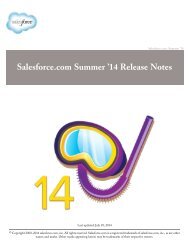Q4 Mobile Security and Risk Review
security-report-Q415-v1.2-EN
security-report-Q415-v1.2-EN
Create successful ePaper yourself
Turn your PDF publications into a flip-book with our unique Google optimized e-Paper software.
<strong>Mobile</strong> Threat L<strong>and</strong>scape<br />
Despite 25 years of developing new security <strong>and</strong> defense techniques,<br />
PC <strong>and</strong> server breaches are at an all-time high. The highest number of<br />
breaches occurred in 2014; 2015 had nearly as many, falling short by<br />
just two breaches. 1 The good news is that mobile computing presents<br />
an opportunity to learn from the security mistakes of the PC era <strong>and</strong> to<br />
adopt a new security model.<br />
With iOS, Apple introduced a s<strong>and</strong>boxed architecture to isolate<br />
data at the app level <strong>and</strong> protect both the file system <strong>and</strong> the<br />
operating system from unauthorized access. OS X, Android, <strong>and</strong><br />
now Windows 10 have followed this model. As a result, all modern<br />
laptops <strong>and</strong> desktops will soon be running an operating system that<br />
looks like a mobile one.<br />
Open File<br />
Architecture<br />
INHERENTLY<br />
IN-SECURE<br />
The mobile operating system architecture uses application<br />
s<strong>and</strong>boxing. This architecture is inherently more secure than the PC<br />
<strong>and</strong> Server architectures because, in mobile computing, operating<br />
system resources <strong>and</strong> data are isolated on an application basis. This<br />
is a fundamental shift from the traditional PC architecture, where<br />
systems resources <strong>and</strong> file access may be simultaneously shared<br />
across applications. Under the traditional PC operating system<br />
architecture, an attacker would distribute viruses, trojans, spyware,<br />
bots <strong>and</strong> other forms of malware through infected files that were<br />
introduced into the PC via malicious email attachment or downloads<br />
from an infected website. Once malware had gained a foothold on<br />
the PC, it was generally free to infect the operating system itself, thus<br />
impacting all apps <strong>and</strong> data on the PC.<br />
INHERENTLY<br />
SECURE<br />
S<strong>and</strong>boxed<br />
Architecture<br />
In contrast to the PC operating system, application s<strong>and</strong>boxing under<br />
the mobile operating system architecture does not permit “crossborder”<br />
penetration of malware from one app to another or from one<br />
app to the operating system. Thus, the focus of an attacker has shifted<br />
from using a file to infect (<strong>and</strong> thus control) a PC to using an infected<br />
app to extract data based on user behavior or inherent vulnerabilities<br />
in the mobile device or network. This typically limits the attack surface<br />
to an app rather than the entire mobile device. But, as we note below,<br />
an infected app might still ultimately enable attackers to control the<br />
mobile device or gain access to personal information or important<br />
corporate data.<br />
1 http://www.csoonline.com/article/3024797/security/data-breach-numbers-still-high-in-2015.html<br />
3 <strong>Q4</strong> <strong>Mobile</strong> <strong>Security</strong> <strong>and</strong> <strong>Risk</strong> <strong>Review</strong>, October 1 - December 31, 2015






